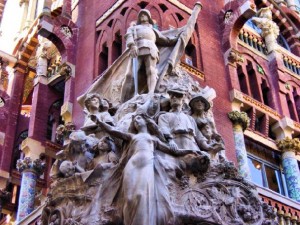Story published previously in Travel Intelligence
A towering mass of humanity stretched towards to the sky. The cherry on the human ice cream cone scampered up the tower with rapidity and precision.
Using the quadriceps of one person as a base, she clutched the waist of the person standing on the shoulders of her current base. Pulling herself higher, she simultaneously draped her right arm over the shoulder above her and placed her left foot on the shoulder below. Within a second she had established her new base, one tier higher.
The petite girl, of no more than ten years, repeated the process until she had successfully mounted the castle. Standing proudly on top, she reached over to the second floor balcony of the municipal building and shook hands with the beaming mayor of Barcelona.
Finally, I had seen one of the famous castells (Catalan for ‘castle’) of the Spanish autonomous region of Catalonia. The castells are a source of great pride for the Catalan people. They believe the construction of the human castles is indicative of the Catalan people’s ability to work in teams, persevere, endure suffering and, ultimately, to succeed. The castells had also been a topic of conversation amongst my friends for months, and a source of anticipation for weeks.
A friend had seen a castell contest the previous year and had raved about it every time we had talked in the six months since I had moved to Barcelona, the capital of Catalonia. A mutual friend, who was watching the contest with me, had planned his visit to coincide with the La Mercé Fiesta at the end of September. La Mercé, like all festivals in Catalonia, had a castell contest.
The first day of the festival meant fewer tourists at Barcelona’s other tourist attractions. Although we had been eagerly anticipating the castells, we decided to take advantage of the opportunity to visit some of the city’s most popular attractions, all things Gaudi, while the crowds were away.
The great architect and designer Antoni Gaudi was responsible for the design of numerous popular Art Nouveau style houses in Barcelona, as well as Park Güell and the Sagrada Familia – two of Barcelona’s most famous landmarks. His works form the backbone of Barcelona’s tourism industry.
Our Gaudi day began, ironically, by deciding to forgo another visit to Park Güell. The gingerbread design houses, colorful lizard statue, cave-like wooden walkways and fantastically creative patio not withstanding, we didn’t need to see it for a third time each.
Casa Batlló and Casa Mila (also known as La Pedrada), both located along the fashionable and architecturally remarkable Passeig de Gracia, were on the agenda. Casa Batlló and Casa Mila boast stunningly innovate façades and imaginative interiors. Casa Mila’s rooftop, with multiple chimneys that resemble helmeted science fiction villains, is particularly impressive.
Departing Passeig de Gracia, on the way to the Sagrada Familia, we made a short detour to see a beautiful house along Avenida Diagonal that I had never seen listed in any guidebooks. My romantic notions that the house was an unknown gem in the gaudy city were dashed when we arrived to find a small tour group outside the house.
The group left shortly after we arrived and followed an unconventional tourist route. Thinking that they were being shown the lesser-known jewels of the city, we scampered after them. One hundred meters down the road, and on an out-of-the way street, we found the group admiring a house with a colorful mural façade. They were exploring the hidden architectural treasures of Barcelona; that was certain.
Our enthusiasm for following the off-the-beaten-path tour, however, was overcome by a powerful demotivator; hunger. It was nearly three and we had yet to eat lunch. A typical Catalan tapas meal of fuet (a dried sausage), butifarra (a sausage that resembles bratwurst), cod and bread smothered in tomato gave us the motivation we needed to embark upon the twenty-minute walk to the Sagrada Familia.
The soaring Sagrada Familia, with its schizophrenic design, is a true marvel. Gaudi began work on the cathedral in 1883 and continued, to the point of obsession, until he was struck down by a streetcar in 1926. Although work has continued on the cathedral continuously, except between 1936 and 1952, it is not expected to be completed until 2020. The finished product will have four façades, each of a different architecture style.
We arrived at the cathedral to find work crews disassembling stages on a blocked-off street. A sinking feeling that we had just missed something big set in. A nearby security guard confirmed our fears. Thirty minutes prior to our arrival, the largest display of castells in all of Catalonia had taken place when more than forty teams had simultaneously built castles.
Stopping at a newsstand on the way to the spectacular fountain display that takes place Thursday through Sunday evenings at the base of Mont Juic, we purchased a La Mercé calendar of events. If there was another castell display, we could not risk missing it. Fate smiled on us, another contest was to take place on the final day of the festival.
To ensure that we had a good viewing position, we arrived early at Plaça St. Juame, where the contest took place. It became apparent, after the competition began, that we had chosen our location well. Each castle was getting progressively taller as they moved closer to us. We weren’t going to have the privilege of seeing forty castells erected in unison, but we were going to get a front row seat for the building of a human skyscraper.
The team nearest us was the fifth group to attempt the successful completion of a castell. The construction of two of the previous four castles had come to an abrupt end when the sheer weight of the tower became too much and the people on the lower levels collapsed. A mass of human bodies came tumbling down on top of them, some from as high as twenty feet in the air. Miraculously, no one had been injured. A gentleman nearby assured us that the castles were only going to get higher and, inevitably, someone would get hurt.
The base of the team’s tower began with two men embracing, hands over shoulders, facing each other. They were then encircled by numerous rows of stout people. Two very sturdy men mounted the still growing base and stood face-to face with arms locked. More circles formed around them.
A two level base was constructed in only a few minutes and, as the third layer began to ascend the tower, members of the team began to fan out into the crowd handpicking men to join the still expanding bottom base.
This was a great opportunity; it was my chance to be a part of a cultural event dear to the hearts of the Catalan people. My friend and the man with whom we had been speaking were snatched away. Before I had time to protest my exclusion, I was grabbed by another team member and ushered off in the opposite direction.
I was placed in the base and told to keep my hands down to my sides and lean into the person in front of me. Additional recruits were soon behind me applying pressure to my back as we all pushed forward. How the men in the middle were not being crushed, I still don’t understand.
I was watching the tower grow above me when a nearby member of the full-time construction team warned me to keep my head down. He told me that, if the tower fell while I was looking up, I might acquire a broken nose, or worse.
Head down, I continued to push and be pushed when there was a sudden lack of resistance to my pushing. In an instant, a knee landed squarely on the crown of my head and I nearly bit off the tip of my tongue. I scolded myself for keeping my mouth open, but held my ground for the team.
I couldn’t see what was happening above me but I could feel the movement. The tower had fallen and people were scrambling down before any more damage could take place. One of the scramblers booted me harshly in the jaw. I had taken two for the team.
After the castle had been completely deconstructed, I went to thank the gentleman for the advice that had kept my nose from being spread across my face. I couldn’t find him in the mass of people, so I went back to my previous location to rendezvous with my friend, who was there waiting when I arrived.
He told me that our castell had been the biggest one yet. I assumed he had been looking up to have noticed and questioned if he had gotten hurt when the tower crumpled. He chuckled and told me that he hadn’t had any desire to be a part of the madness. He had waved off the man who had grabbed his shoulder and returned to our spot. The work of which I had been a part was the tallest of the day, he assured me.
Later, as were walking on Las Ramblas, I rubbed my suddenly aching lower back, confirmed that I still had full range of motion in my bruised jaw, wondered if I had any aspirin to relieve my headache and silently cursed my friend for not wanting to take part in the cultural activities.




